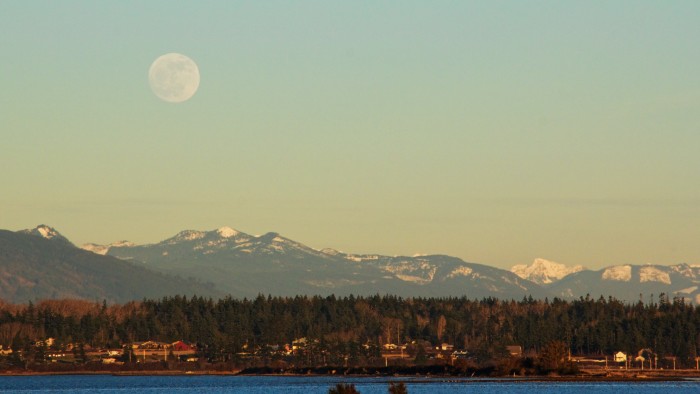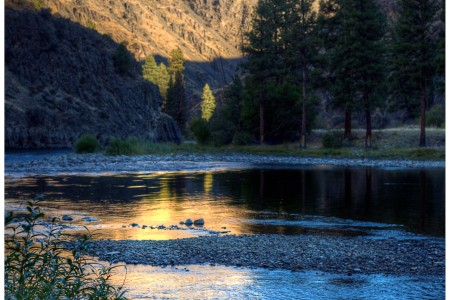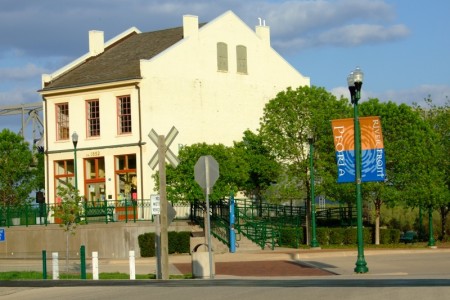Placing Fairness at the Root: Three Case Studies in Conservation Finance Justice

In Brief
Conservation practitioners are evolving the mainstream practice to include consideration of social equity.
In forests, urban districts, and foundation boardrooms, they're infusing the history of past wrongs into forward-looking strategies.
The case studies here cap a semester of research and invite practitioners to a new phase of impact.
For an alternative version of this article's text with footnotes and sources, open this link.
Environmental justice in land conservation requires practitioners to slow down and consider the foundations that exclude or enable relationships with and control over land. The following stories highlight three organizations using conservation finance strategies to advance environmental justice outcomes.
Each considers the history and context that has led to the land ownership, land use patterns, policy decisions, and wealth accumulation in the places where these groups work. In each story, participants have asked: why is this so? They have spent time listening to community groups and tribal nations to understand what these groups desire, and have worked creatively to identify solutions towards these aims. These organizations are working in the intersections between land and human justice, giving consideration to the intertwined rights of natural and human communities.
In these cases, justice means broadening the definition of conservation to ensure more people benefit, using conservation funds in new ways in order to ensure co-benefits, and expanding the group of people with power to make decisions about land use.
- The story of the Swinomish Forest Bank illustrates how ecosystem markets can be inaccessible to Indigenous peoples due to histories of land fractionation and presents a strategy that respects and acknowledges this history while also creating new legal structures to enable that access.
- Greenprint Partners’ work with the city of Peoria illustrates how community organizing strategies can use public investments in green infrastructure to support community benefits.
- The Doris Duke Charitable Foundation is using its philanthropic funding to expand the diversity of people working in the conservation field, encouraging conservation organizations to better connect with justice efforts, and funding organizing capacity at a local, grassroots level in BIPOC communities.
Each of these efforts broadens the definition of what is considered a conservation organization, and what is imperative for conservation groups to consider.
The Swinomish Forest Bank
The traditional territory of the Swinomish Indian tribe extended throughout the Salish Sea region of northwest Washington state, and includes the lands surrounding the Skagit and Samish River Valleys; the Skagit, Padilla, and Fidalgo bays; and the Fidalgo, Camano, Whidbey, and San Juan Islands. Today, land managed by the Swinomish has been reduced to a 15-square mile reservation on Fidalgo Island. Within the designated reservation boundaries exists a checkerboard of public, private, and tribally owned lands; private lands are owned by both Swinomish citizens and non-Swinomish people. The Swinomish Tribal Government owns in trust and in fee a very small percentage of the overall reservation land in a patchwork of small, non-contiguous parcels. The tribe has been working for many years to knit together land, and especially forestland, within the reservation. It currently holds title to about 1,200 of the reservation’s 4,500 acres of forestland. Due to this heavily fragmented landscape, the Swinomish have faced significant barriers to implementing landscape-level forest management strategies.
In 2014, the Swinomish asked Ecotrust, a nonprofit that works across the Pacific Northwest to support equitable, climate-resilient land stewardship and economic development, for help developing a new forest management plan. The Swinomish had previously worked with Ecotrust and appreciated both its forestry expertise and willingness to work collaboratively in order to advance Swinomish goals. The Swinomish sought Ecotrust’s technical expertise towards their wish to unify land management practices across their fragmented acreage.
One strategy involved creating a forest bank, which is a new legal entity wherein the owners of individual parcels of land (which in this case could include the Swinomish Tribal Government, tribal members, non-tribal residents, and others) enroll in the forest bank. The forest bank manages and harvests enrolled parcels according to a unified forest management plan, enabling landscape-scale management strategies that are impossible on small parcels. Many climate resilient forest management practices, a priority for the Swinomish, are only possible on this large scale.
As the Indian Land Tenure Foundation says, “Today, the loss of tribal lands combined with the mixed ownership patterns within reservation boundaries poses serious challenges for the sovereignty and self-determination of Indian nations.” The Swinomish’s checkerboarded and fractionated landscape exists due to the imposition of private property boundaries atop traditional, collective management regimes. The legacies of fractionation have harmed the tribe’s ability to control their land.
Fractionation formed part of the process of colonization. The United States Government imposed private property ownership structures and oversight systems on the traditional territories of Native Americans. The government defined a system of reservations and restricted Native Americans to only these areas, which were often a mere fraction of the size of traditional territories. In so doing, the Government forced participation in the United States’ private property frameworks rather than respecting many Native Americans’ collective and relational conceptions of land and land use migration patterns. These actions took place by force, by treaty, and by allotment.
In 1855, the U.S. Government and the Swinomish tribe signed the Treaty of Point Elliot, which defined 15 square miles on Fidalgo Island as the Swinomish reservation. Despite this, the Swinomish had to fight to protect their treaty-defined land base in 1873, when President Grant attempted to further reduce their land base (a move which the U.S. Supreme Court blocked). Within the 1887 General Allotment Act (which many call the Dawes Act) the U.S. government awarded 40- to 160-acre parcels of land within the reservation to individual families, both Native American and settlers, with the aims of encouraging the establishment of settled, agrarian societies. As these parcels went to successive generations, land was subdivided and fragmented into smaller and smaller parcels (thus the term fractionation).
The Swinomish anticipated that a large carbon credit sale might help them “seed” the forest bank: proceeds from the sale would create a source of capital to allow purchase of more acreage and compensate individual landowners for ecosystem services.
Due to this history, typical barriers to landscape-level management and accessing markets for ecosystem services such as parcel size, forest cover and composition, and past management regimes are compounded. Unifying land through a forest bank would aggregate management across parcels with the potential for both climate resilient and financially beneficial outcomes. The Swinomish anticipated that a large carbon credit sale might help them “seed” the forest bank: proceeds from the sale would create a source of capital to allow purchase of more acreage and compensate individual landowners for ecosystem services.
In 2015, Ecotrust and the Swinomish received a USDA Conservation Innovation Grant to support their work to revise the Swinomish Forest Management Plan. The partners established a stakeholder group of tribal members to provide input on the project. Brent Davies at Ecotrust said about the committee: “Rather than practice co-management, we were seeking to put indigenous communities in the driver's seat.” This involved both carefully considering the Swinomish’s wishes for how forest resources could be managed using climate-smart practices and considering different governance models for establishing the forest bank within the legal constructs governing tribally owned and managed lands.
Because there are few forest bank models, Ecotrust and the Swinomish worked together to envision what an appropriate structure and entity might look like. The Swinomish and Ecotrust together completed their new forest management plan in 2018, which includes an intention to establish a forest bank. Ecotrust and the Swinomish continue to work together towards this aim.
Peoria and Greenprint Partners
Peoria contains one of the poorest zip codes in the country and is a majority-minority community. In 2006, the EPA declared Peoria in violation of the Clean Water Act due to stormwater and sewer overflows, and mandated that the city address these hazards. Though underfunding has resulted in significant infrastructure failures, Peoria’s leaders have sought to use philanthropic and public capital to upgrade infrastructure while also investing in community assets.
Peoria is not unique. Because of histories of disinvestment and redlining (racially discriminatory mortgage lending practices), many urban areas have underfunded and failing infrastructure. In 2014, Peoria won a Bloomberg Philanthropies Innovation award to create a Chief Innovation Officer staff position. With this added capacity, the city contacted Greenprint Partners, a women-run, green stormwater design and project engineering firm. The city needed to make large public investments to comply with the EPA mandate, and wanted to work with a partner who could help them creatively deploy these funds to also benefit the community.
Greenprint says on its website that it aims to develop equitable, scalable, holistic stormwater solutions that also revitalize neighborhoods, increase public health and safety, and create new job opportunities in low- to moderate-income communities. A key element of Greenprint’s model is to thoughtfully deploy large public investments in infrastructure to simultaneously incorporate community benefits and community goals. As co-founder and CEO April Mendez commented: “We believe that infrastructure could be developed and designed with communities in mind, but only if the community is centered from the beginning.”
The city of Peoria was a great partner, said Mendez, because it was willing to “design green stormwater infrastructure with the perspective that the parts of the community that most needed this infrastructure also needed other organizational supports.” With support from a $940,800 grant from the USDA’s Conservation Innovation Grant program, Greenprint established a stakeholder advisory group that was representative of the full community’s demographics.
Greenprint asked this group what they needed and what they wanted to see in their community. Rather than rely upon traditional, expert-driven infrastructure project models, Greenprint asked the community to say what their goals were and figured out how to create infrastructure that would satisfy those goals. The advisory group identified local employment opportunities, access to healthy food, and accessible urban green spaces as priorities.
Together, Greenprint, the city of Peoria, and the stakeholder advisory group decided to develop a 1.5 acre farm that can slow, sink, and store stormwater runoff while also providing job training and educational opportunities in growing food and running a farm business. Greenprint facilitated a placemaking visioning exercise, inviting community members to share ideas about what the farm might look like, and the types of infrastructure it would have. The farm was intentionally located in one of the poorest parts of Peoria, thus ensuring that both its stormwater retention and job training benefits stayed in the community of most need. The project team named this farm The Well Farm. In major rainstorms since this infrastructure was installed, it has absorbed 98% of rainfall.
Greenprint seeks to bring principles from its founders’ community organizing backgrounds to its work. Though April Mendez acknowledged that equity-centered work can cost more in staff and design time, she said: “Community engagement changes the end product… It’s not box checking, it’s about changing the design of what you’re building.” She continued: “It’s important to have the creativity to design things from a multi-benefit and place-making perspective and not just think about putting the facility in the ground.”
This multi-benefit perspective has had important ripple effects. This project is one that the community is excited about and will benefit from in multiple ways. It also has created potential opportunities for public utilities and public infrastructure funding programs to simultaneously fund equity and community development outcomes. Greenprint estimates that for every $1 invested in establishing Well Farm, $1.50 in community benefits flow out.
Upon its completion in 2019, the $1.9 million Well Farm received a number of accolades from green infrastructure thought leaders, industry groups, and foundations. These include the prestigious U.S. Water Prize from the U.S. Water Alliance. Other recognition came from the Illinois Green Alliance Emerald Award and the Sun Foundation Making Waves Award. This project also informs Peoria’s stated goal to address its clean water mandates with entirely green infrastructure.
Greenprint is working with the National Green Stormwater Infrastructure Exchange to design an educational accelerator program to train other municipal planning and finance entities who are interested in implementing similar “water equity” projects. With the recently signed Infrastructure Investment & Jobs Act committing $55 billion to wastewater, stormwater, and drinking water infrastructure, there is an opportunity to use public funds to support community benefits and water infrastructure goals simultaneously.
The Doris Duke Charitable Foundation
The Doris Duke Charitable Foundation (“Doris Duke” for short) has rethought its goals and processes to better root its grantmaking in equitable decision making and work under an expanded definition of conservation. Four programs of the foundation highlight this evolution.
In 2020, according to Green 2.0, approximately 30% of staff, 25% of leadership, and 32% of board members at U.S. environmental nonprofits identified as people of color. Each of these metrics has increased significantly since 2017 when Green 2.0 began compiling this data. Doris Duke has carefully considered who holds power and positions in the environmental movement, and it has reoriented grantmaking in support of a more diverse talent pipeline. For many years, the Doris Duke Conservation Scholars program supported masters-level students in environmental studies and land conservation. In 2013, Doris Duke changed the Doris Duke Conservation Scholars program to fund college-age, BIPOC (Black, Indigenous, or People of Color) young people to build conservation careers. By funding students at the undergraduate level, Doris Duke seeks to create earlier exposure to environmental work for BIPOC youth, making this a more tangible professional path. Building a diverse pipeline of young conservation practitioners will help facilitate a more diverse group of staff and leadership at environmental non-profits.
Doris Duke’s Diversity, Equity and Inclusion Capacity Building Program was created in 2020 to provide capacity to both white- and BIPOC-led conservation organizations. Doris Duke awarded 2-year grants of up to $60,000 to organizations ranging in size from The Conservation Fund (with hundreds of staff) to the Utah Diné Bikéyah (8 staff), to support staff engagement in diversity, equity, and inclusion capacity building, organizational assessments, and structural changes.
In 2020, according to Green 2.0, approximately 30% of staff, 25% of leadership, and 32% of board members at U.S. environmental nonprofits identified as people of color. Each of these metrics has increased significantly since 2017.
Doris Duke’s new “Inclusive Conservation” grant program launched in 2021. Doris Duke partnered with an advisory committee of conservation practitioners who primarily represent and serve BIPOC communities to develop this program, which invests in “culturally driven and community-centered conservation work that builds more positive outcomes for biodiversity, nature and people.” These expanded parameters of what conservation is creates a broader set of activities for Doris Duke to fund. The advisory committee nominated organizations who could then apply for grants.
This program awarded long-term, unrestricted, $300,000 grants to five organizations (‘Aina Momona, Ekvn-Yefolecv, McIntosh S.E.E.D., Native Movement and Soul Fire Farm) for the work that each organization does to “prioritize the bridge between environmental and land justice” and “in recognition of and contribution to the pivotal leadership roles they play” in doing inclusive, human- and equity-centered conservation work.
Doris Duke and the Robert Wood Johnson Foundation, together with the Prevention Institute, created the People, Parks, and Power program to geographically redistribute where conservation dollars go. These partners initiated this partnership in 2021 in order to support community organizations “working in urban, low-income communities of color across the United States to increase park equity through local policy and systems change.” Histories of racially exclusionary housing finance (i.e. redlining and racially restricted federal lending programs) and racial covenants prohibiting home ownership by people of color or other ethnic groups have shaped today’s cities. Historically redlined neighborhoods typically are made up of majority renters, have less-well funded schools, have fewer public funds invested in natural amenities, and are often majority BIPOC communities. Black, Latinx, and Asian communities are more likely to live in historically redlined and today, nature-deprived areas - meaning, areas without access to trees, streams, or parks, or poorly maintained park amenities - and thus less access to the benefits parkland offers, such as physical exercise, mental well-being, and clean air, water, and cooling.
Lack of urban access to green space is also a result of the rural bias of land conservation. This is a result of factors like the funding priorities of private, philanthropic, and public conservation funders and the fact that conventionally defined biodiversity conservation targets (i.e. presence of large carnivores or minimum acreage thresholds) most often are found in the large tracts of undeveloped land more readily found in rural landscapes. Because conservation is reliant on philanthropic gifts to support its work, it often happens nearer to where well-resourced communities live. As Sawyer Cresap commented in her recent article on equitable conservation finance: “Low-income communities and communities of color are markedly deprived of access to privately conserved open spaces and less frequently affiliated with private land conservation as land donors, visitors, members, staff or board.” Conservation dollars are much less often invested in urban landscapes, and the outcomes that conservation organizations seek to achieve have been defined by perspectives and beliefs that give less weight to urban parklands.
Doris Duke is seeking to support the organizations and community members who are working on the ground to address the underlying reasons why certain places are underserved by park and other infrastructure.
As it brings a portion of its grantmaking into urban areas, it hopes to not only improve green spaces in urban areas, but more importantly to seed power and capacity among local groups. It seeks to support these groups in building new narratives and greater participation, access to resources, and authority over land use decisions. Philanthropy “holds normative power to make things mainstream and render them visible” through deciding what to fund and which stories to elevate, said Sean Thackurdeen, Program Associate for the Environment at the Doris Duke Charitable Foundation. Through continued consideration of how it invests philanthropic dollars, Doris Duke seeks to give both resources and power to BIPOC communities, enabling them to create, implement, and share their visions for what land conservation could be.
Conclusion
These case studies showcase ways in which some conservation practitioners are taking responsibility for the histories, policies, stories, and circumstances that have led to the patterns of land and wealth ownership we see today. These patterns are rooted in discriminatory practices like fractionation and redlining, which have harmed many non-white communities and restricted their ability to own and manage land. Said in a different way, traditional measures of conservation success will feed off of longstanding and systemically-reinforced inequities in wealth, power, and control, and will continue to produce inequitable outcomes in who the benefits of land and resource conservation accrue to. Without directional shifts and justice-oriented recalibrations, those with historical access to resources like land will be able to access conservation benefits predicated on land ownership and accumulate additional and compounding wealth, while those who have been systematically denied access to land will not have the same opportunity.
The organizations above have sought to ensure that the outcomes and benefits of their work do not only accrue to those who already have resources. In place-based, historically informed, and community-defined ways, they have both broadened and expanded what conservation is and who conservation is for. They are working with and ceding power to new partners. How can these groups’ willingness to listen and learn and change serve as models? How might these examples inspire future steps along the long journey towards just conservation?
Practitioner Reflections:
- How would your organization answer the question, why does property ownership in our landscape look the way that it does? How is unequal access to land and wealth evident in your operating area today? What historical responsibility might you, individually or organizationally, hold? What could your organization or firm’s role in addressing these histories be?
- How would your organization answer the questions, what is the conservation we practice, and who is it for?
- Who has authority and decision-making power in your organization? How do you partner with other groups in your community? Who is in the “driver’s seat” in your partnership projects?
- What are the specific histories of Native American communities in your region? Who used to call your current region home (see native-land.ca)? Which Native American communities continue to call this place home? If they are no longer here, where did they go (see https://nativeland.info/)?
- What do the actions of Ecotrust, the Doris Duke Charitable Foundation, and Greenprint make you think about? Is there anything in the above three case studies that your organization might consider adopting?
This essay summarizes my own understandings of the conservation field and its intentional and unintentional perpetuation of injustice. Any mistakes or omissions in this story are my own.


